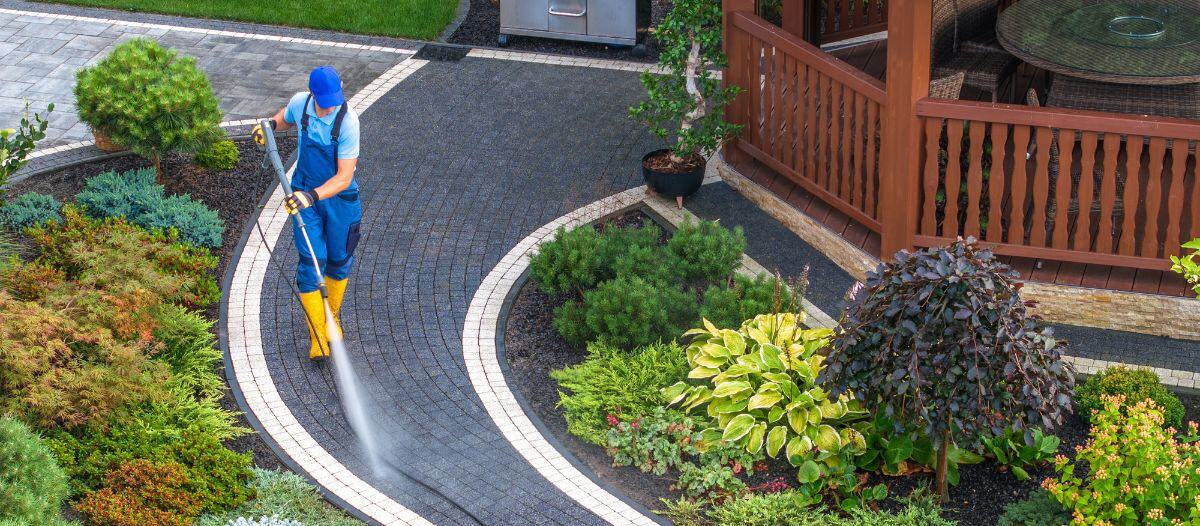Spring Renewal
Taking advantage of better weather for engagement & maintenance

As winter thaws into spring, facility and commercial real estate professionals face a season of both opportunities and challenges. The warmer weather is a welcome change that brings longer days and renewed energy, but it also uncovers maintenance issues left in winter’s wake. For property managers, spring is the time to refresh buildings, revitalize landscapes and enhance tenant experiences after months of cold and snow. It is a seasonal pivot point in which proactive efforts can pay dividends in curb appeal and tenant satisfaction.
Seasonal maintenance & inspections
Exterior cleaning & repairs: Clean away winter grime and repair damage. Power wash building exteriors, sidewalks and parking areas to remove winter salt, dirt and pollutants that could deteriorate surfaces. Remove debris from gutters and walkways; clear all remnants of winter salt and grime from parking lots and sidewalks; and fix any potholes or signage damage caused by snowplows to eliminate safety hazards. Touch up exterior paint or sealant as needed to protect against summer sun and rain.
Landscaping refresh: Revitalize the landscape and curb appeal. Clean up any dead plants, fallen limbs and debris left over from winter. Prune shrubs and trees and consider planting fresh flowers or adding new mulch to give the property a vibrant, well-kept appearance. A well-maintained landscape not only looks attractive but can also prevent issues (like overgrown branches or roots affecting structures). Ensure irrigation systems are tuned up before peak use; check all valves, sprinkler heads and water pressure to address leaks or clogs before regular watering schedules begin.
HVAC service & performance check: Prepare cooling systems for hot weather. Spring is the time to schedule professional HVAC maintenance. A properly tuned air-conditioning system will improve energy efficiency, cut electricity costs and maintain good indoor air quality during the hot, humid months. Arrange for HVAC servicing every spring (and fall) to clean coils, replace filters and verify all cooling equipment is in working order when it is needed most. This preventive maintenance helps avoid breakdowns during peak summer heat and keep tenants comfortable.
Roof, gutter & exterior inspection: Inspect the building envelope for issues. Conduct a thorough walk-around inspection of the property’s exterior. Inspect roofs and gutters for leaks, debris buildup, or damage from spring rains or winter ice. Clear out gutters and downspouts to ensure proper drainage during summer storms. Check windows and doors for any cracks, drafts or failed weather seals, and repair caulking or weatherstripping to keep cooling costs down. Ensure all window screens are intact to allow ventilation while keeping pests out. Addressing these structural and envelope issues early prevents small problems from becoming major repairs under summer conditions.
Plumbing & irrigation systems: Prevent water issues. Examine plumbing lines and outdoor water systems for leaks or low pressure as seasonal use resumes. Pay attention to irrigation pipes and exterior spigots that may have been damaged by freezing; fixing leaks now conserves water and prevents damage. Ensure drains and stormwater systems are clear to handle heavy summer downpours. Checking these systems in spring averts water waste and property damage during summer.
Pest control: Implement seasonal pest prevention. Warmer weather brings out pests, so schedule preventive pest control treatments in spring. Treat for insects common to the area and eliminate conditions that attract pests. For example, remove standing water to reduce mosquitoes, and inspect for signs of termites, ants or rodents around the property’s perimeter. Sealing cracks and ensuring trash areas are clean will help keep pests out and protect both the facility and tenant comfort.
Tenant engagement & events
Seasonal tenant appreciation events: Host community-building activities to thank tenants. Plan informal gatherings that take advantage of the pleasant weather. For instance, organize a spring coffee/breakfast in the courtyard or a summer tenant cookout or ice cream social. These appreciation events foster a sense of community and show tenants they are valued. Outdoor movie nights or community volunteer clean-up days are other great options in warmer weather. Tailor events to the tenant mix (professional networking mixers for office tenants or family-friendly socials for mixed-use properties) to maximize participation and goodwill.
Networking opportunities: Facilitate tenant interaction and professional networking. Create opportunities for tenants to connect with one another, which can enhance their experience in the building. Consider hosting casual networking gatherings like a tenant breakfast or lunch in common areas. Tenants often appreciate the chance to meet their neighbors; such events can spark valuable professional and personal relationships. Even a monthly coffee hour or meet-your-neighbor session in the lobby can strengthen the community vibe and tenant satisfaction.
Wellness initiatives: Promote health and wellness among tenants. Leverage spring and summer to roll out wellness programs. Host on-site fitness classes (yoga sessions or walking groups during lunch) or invite experts for health workshops. For example, offer classes, nutrition seminars or other wellness workshops on site to help tenants de-stress and stay healthy. Partner with local gyms or instructors for discounted classes or organize a building-wide wellness challenge if there is an on-site fitness center. Supporting tenant well-being demonstrates a commitment to their quality of life and can increase tenant loyalty.
Tenant engagement in sustainability: Align with tenants on green initiatives. Involve tenants in sustainability efforts to maximize impact, form a green team with tenant representatives to brainstorm and promote building-wide eco-friendly practices (Earth Day events or incentives for reducing office waste). By getting tenants invested in sustainability, a culture is created in which everyone contributes to energy, water and waste reduction, amplifying the results of the initiatives.
Communication & engagement: Maintain open, proactive communication with tenants. Keep tenants informed about summer maintenance schedules, building improvements or any seasonal protocols. For instance, send a spring newsletter or regular email updates with tips (like energy-saving practices in hot weather) and information on any upcoming work on the property. Encourage feedback and promptly address tenant concerns. Responding quickly to maintenance requests and communicating clearly about on-site activities builds trust and keeps tenants feeling valued. Engaged and informed tenants are more likely to renew leases and take care of the property.
Emergency preparedness
Storm readiness plan: Develop and update an emergency plan for severe weather. Spring and summer can bring thunderstorms, tornadoes or hurricanes depending on the region. Ensure there is a written emergency preparedness plan that covers various scenarios (storms, floods, extreme heat, etc.). The plan should include defined evacuation routes, designated shelter-in-place areas (interior hallways or basements for tornado safety), and roles/responsibilities for staff during an emergency. Communicate the plan clearly to tenants and staff so everyone knows what to do if severe weather strikes. Post evacuation maps and emergency contact information in common areas for quick reference. Regularly review and update this plan to incorporate any changes in building layout or occupancy.
Securing the property: Harden the facility against storms. Before storm season, inspect and secure any loose items outdoors that could become projectiles in high winds. This includes patio furniture, signage, trash bins and equipment; store them or anchor them down. Trim overhanging tree branches or remove weak limbs near buildings and power lines to reduce the risk of property damage or outages. Ensure roof drains and gutters are clear to prevent water backups during heavy rain. If the property is in a flood-prone area, consider proactive measures like sandbags or temporary flood barriers when severe storms are forecast. Taking these steps in advance can significantly minimize storm damage.
Training & drills: Empower the team and tenants through emergency training. Make sure property management staff are trained in first aid and emergency response procedures. Conduct periodic drills or simulations for scenarios like fire evacuations or shelter-in-place for tornadoes so that everyone knows their role and remains calm under pressure. Invite tenants to participate in fire drills or hold an annual safety briefing for all building occupants. Employees who are trained and drilled on evacuation protocols and first aid will respond more effectively and help others in a real emergency. Partner with local emergency services for guidance or even joint drills. An informed, practiced building population is a safer one.
Budget planning & operational efficiency
Mid-year budget review: Revisit financials and adjust for seasonal needs. For many organizations, the spring and summer months are a good mid-point in the fiscal year to assess operating budgets. Take the opportunity to review year-to-date expenses on utilities, maintenance and services, and compare them to projections. Because it is halfway through the year, trends can be identified and rebalanced accordingly. Use this insight to refine the summer budget, allocate additional funds for areas like increased HVAC usage or landscaping, and look for savings elsewhere. Smart mid-year adjustments can prevent budget overruns and improve cost efficiency.
Staffing & vendor management: Align the team and vendors with seasonal demands. Warmer months may require shifting resources; ensure there is adequate maintenance staff or contractor support for the increased workload. For instance, adjust janitorial schedules if the building sees heavier use or extended hours in summer (for example, if tenants host after-hours events, make sure cleaning staff can accommodate). Likewise, verify that security or engineering staff schedules align with any summer changes (like earlier building open times or weekend events). Regularly meet with key vendors to set summer expectations and ensure service levels are met efficiently. Proactively managing staffing and contracts keeps operations smooth and cost-effective, preventing overtime surprises or service lapses.
Safety & security considerations
Security System Audit: Evaluate and upgrade building security systems. Take time in the spring to inspect all security equipment, surveillance cameras, access control systems, intercoms and alarm systems to ensure they are functioning properly and covering the necessary areas. Test alarm panels and backup batteries, and review camera footage quality and coverage zones. If any cameras or sensors are malfunctioning or if there are blind spots on the property, address them before summer activity picks up.
Lighting & visibility: Enhance lighting to deter crime. Longer daylight hours do not eliminate the need for good nighttime lighting; if anything, summer can bring increased evening activity around properties. Ensure all outdoor lighting (parking lot lamps, entrance lights, walkway illumination) is operational and adequate. Replace burnt-out bulbs and consider brighter LED upgrades for efficiency and better visibility. Strategic lighting is one of the simplest and most effective crime deterrents: well-lit areas make it harder for trespassers to hide and easier for cameras or people to spot suspicious behavior. Best practices are to install motion-activated lights in low-traffic areas and set interior lights on timers to give the appearance of occupancy even after hours. This visible vigilance can instantly put off would-be intruders from targeting the property. Additionally, trim landscaping near entry points and along walkways to eliminate hiding spots and keep sightlines clear.
Access control & lock procedures: Tighten controls on entry points. Review how tenants, visitors and contractors access the building during summer months. If more foot traffic is expected (tourist season in a retail property or more visitors to an office), ensure access control systems (key cards, codes, visitor sign-in) are robust. Update access codes or reissue keys if any have been lost or if there have been tenant turnovers. Emphasize to all tenants and staff the importance of securing doors and windows when areas are unoccupied; an unlocked door just for a minute can invite theft. Consider adding door alarms or self-closing mechanisms to any frequently propped-open doors.
Safety equipment & inspections: Check all life-safety systems and equipment regularly. While focusing on security, do not neglect basic safety hardware. Test emergency exit door alarms and ensure exits are not obstructed or misused. Verify that stairwell doors are functioning (and not propped open) and that all exit signs are illuminated and emergency lights work properly (they should last at least 90 minutes on backup power per many codes). Summer storms can cause power outages, so it is vital these guide lights are operational. Inspect first-aid kits or automated external defibrillators (AEDs) on site and replenish supplies as needed. For properties like shopping centers or campuses, if outdoor amenities are provided (grills, fire pits, pools), make sure safety rules are posted and equipment is in safe condition (pool rescue equipment in place, fire extinguishers near grilling areas). Prioritizing these safety checks will help prevent accidents and ensure a prompt response if one occurs.
By focusing on these key areas, facility managers can ensure their properties are well-prepared for spring and summer. Implementing these best practices can help maintain efficient operations, enhance tenant satisfaction and protect the property’s value during the busy warmer months. Experienced property professionals know that a proactive approach now means fewer headaches and a smoother-running property all season long. Each year, revisit and refine the spring/summer plan to continuously improve and adapt to new challenges, keeping the commercial property a safe, inviting and cost-effective place for everyone who uses it.











